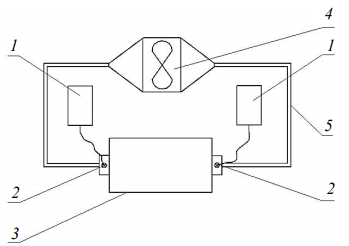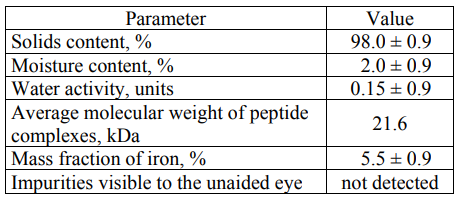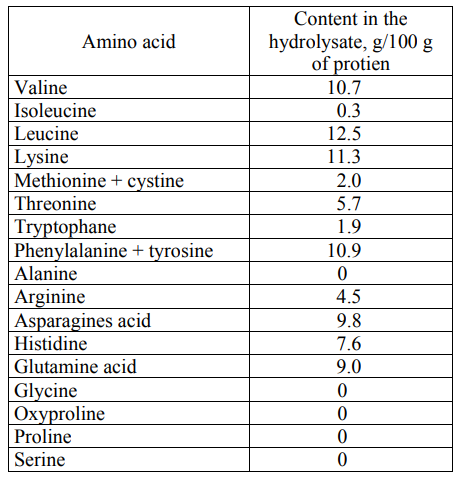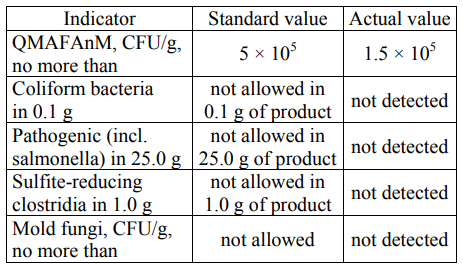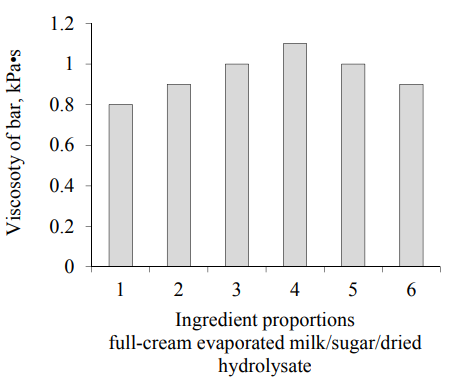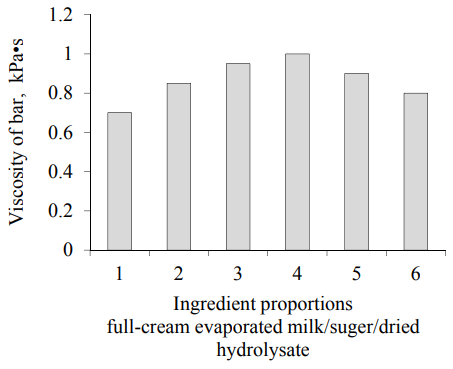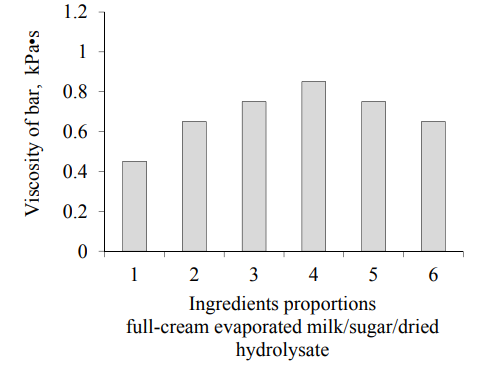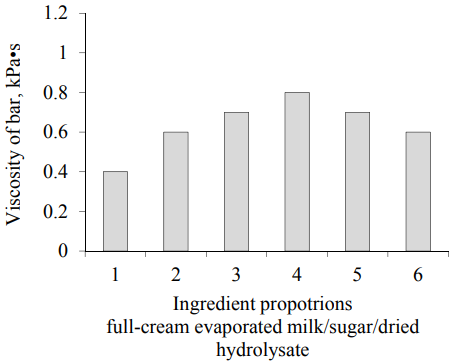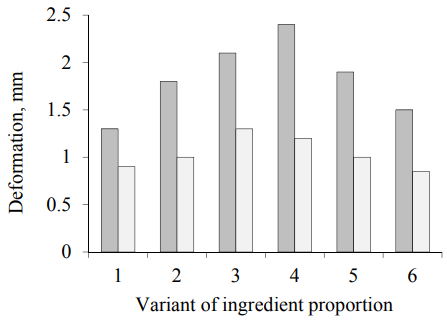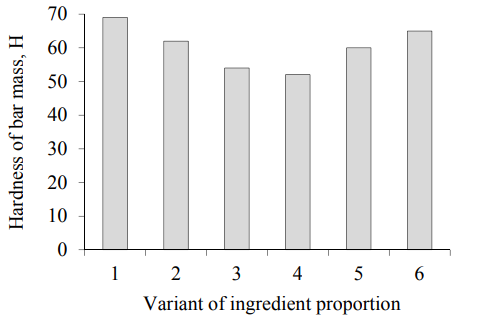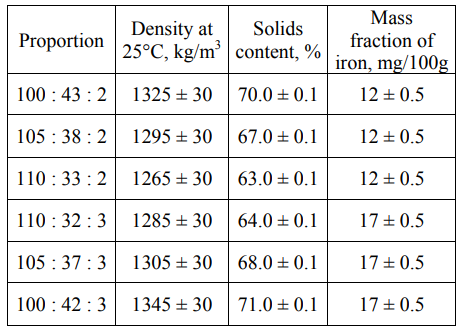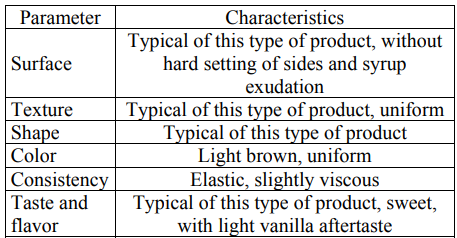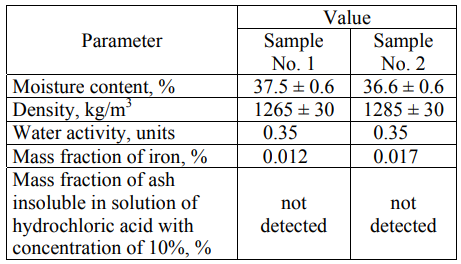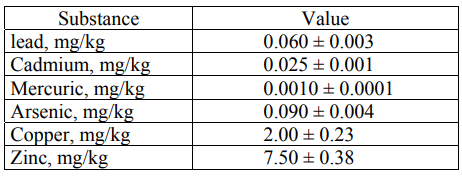Аннотация
Due to natural resources scarcity, farm animal blood processing to make functional food products is current task. The most promising direction is the isolation of iron-containing components from blood to obtain food products for the prevention of iron deficiency. Having analyzed disadvantages of existing techniques, we decided to use easily digestible heme iron and amino-peptide complexes obtained after the hydrolysis of red blood cells as an anti-anemic base. The scientific novelty of the research work consists in using the dried hydrolysate of packed red blood cells in developing a confection intended for the prevention of iron deficiency. Common methods were used in the investigation. Analysis of physicochemical, microbiological, and toxicological properties of the dried hydrolysate of red blood cells has been performed. Also, work on formulations of a confection, namely, sherbet-type bar containing the dried hydrolysate of red blood cells as an anti-anemic component has been carried out. In order to understand an effect of ingredients and develop the optimal processing technique, rheological properties of final bar have been studied. According to the results of the research, the dried hydrolysate of red blood cells conforms to safety requirements of SanPiN 2.3.2.1078-01. Two optimal formulations of the sherbet-type bar with anti-anemic agent based on farm animal blood have been chosen. It has been proved that such toxic elements as lead, cadmium, zinc, copper, arsenic, and mercuric, as well as pathogenic organisms are absent or within normal range.Ключевые слова
Confection, anti-anemic properties, farm animal blood, formulation, processing techniqueВВЕДЕНИЕ
In the light of natural resources scarcity, the use of secondary raw materials in manufacturing functional food products is of relevance [1]. It is a matter of importance to give functional properties to these products to increase their marketability and profitability in the future.
Slaughter animal blood processing allows various products to be obtained [2]. One of common used ones is a product for the prevention of iron deficiency in humans. This direction has not yet been studied sufficiently hence, searching for new technical solutions is actual task [3].
The main drawback of existing products from slaughter animal blood consists mainly in using black food albumin, which is stabilized and dried whole blood or packed red blood cells of slaughter animals (packed RBCs), as an iron-containing component.
The low efficiency of food albumin is due to fairly complicated digestion for proteolytic enzymes because of the membrane stability of dried aggregated red blood cells. It is known that the absorption of iron takes place in a duodenum only, where black food albumin is mainly in an undigested form, which leads to pathogenic microorganism growth [4].
Thus, the use of easily digestible iron form and amino-peptide complexes obtained by the hydrolysis of red blood cells is a decision, which can exclude the disadvantages mentioned above.
It should be taken into consideration that protein hydrolysate is a good source of amino acids, which are being in a free state [5, 6]. Under conditions of human anemic states, amino acids would have a positive effect on both iron absorption and general state of man [7].
In previous works on obtaining an easily digestible form of iron from slaughter animal blood, the method of blood stabilization followed by fractionation for maximum yield of red blood cells from total blood bulk has been presented. Also, hydrolysis parameters for maximum proteolysis of protein components of packed RBCs have been described [8, 9].
The research is aimed at making the confection, namely, a sherbet-type bar containing the dried hydrolysate of packed RBCs as a component for the prevention of iron deficiency. Also, the aim of the work is to study physicochemical, microbiological, toxicological, and rheological properties of final product.
ОБЪЕКТЫ И МЕТОДЫ ИССЛЕДОВАНИЯ
Theoretical and experimental investigations are carried out at the Research Institute of Biotechnology and the Department “Bionanotechnology” (Kemerovo Institute of Food Science and Technology (University), Kemerovo, Russia).
The subjects of the study were dried hydrolysate of packed red cells from cattle blood and a confection made of such ingredients as full-cream evaporated milk, sugar, dried hydrolysate of packed red cells from cattle blood, vanillin, and ascorbic and citric acid.
The following equipment was used in conducting the investigation: analytical balance AND HR-202i (A&D, Japan), double distillation apparatus TKH25-11.15.92-81 BC.W39 (Russia), drying cabinet SHSvL-80 (Russia), Tarr-Baker gelometer (Russia), electrical oven SNOL («Umega», Lithuania), pH-meter SevewCompact (MetterToledo, the U.S.A), and spectrophotometer UV 1800 (Shimadxy, Japan).
Solids content in dried hydrolysate of packed RBCs was determined according to GOST 30648.3-99.
Moisture and solids content in the bar were determined in accordance with GOST 5900-73.
Moisture content in dried hydrolysate of packed RBCs was determined according to GOST 33319-2015.
Water activity was determined indirectly by means of the unit, the schematic diagram of which is showed in Fig. 1. The indirect method is based on tentative determination of equilibrium relative humidity in the working space of the unit.
A silicone hose (5) joins all the elements of the unit, forming a closed circuit where a ventilator (4) forces air to move. Sensitive measuring elements IT5 – TR-2 “Termit” (2), being at the inlet and outlet of the working chamber (3), display measured values of temperature and relative air humidity.
Determination of water activity in foods includes two stages – preparatory and principal. The former involves draining the working circuit, while the latter determines the equilibrium relative air humidity in the working circuit. The water activity value aw was calculated as follows:

where ERH is the equilibrium relative air humidity in the working circuit, %.
The average molecular weight of amino-peptide complexes was determined as follows. Molecular mass distribution of proteins was estimated electrophoretically by means of Laemmli method (in polyacrylamide gel (PAAG)). Amino acid sequence of peptides formed was determined by automatic sequencer operating according to the Edman method. The method is based on the treatment of the study sample with phenyl isocyanate, which leads to cleaving one amino acid from the N-terminus of the sequence, and identifying the amino acid by liquid chromatography under pressure.
Iron content in the dried hydrolysate of packed RBCs was measured in accordance with GOST 26928-86.
The content of mesophilic aerobic and facultative anaerobic microorganisms in both the dried hydrolysate and the bar mixture was calculated according to GOST 10444/15-94, coliform bacteria – GOST R 52816-2007, yeasts and mold fungi – GOST 10444.12-88. Determination of salmonellae was carried out in accordance with GOST R 50480-93 by inoculating the Kauffmann medium and then, the Endo agar. The content of sulfite-reducing clostridia was calculated according to GOST 29185-91.
Determination of toxic substances content was also carried out by GOST. The content of lead and cadmium in both the dried hydrolysate and the bar mixture was measured according to GOST 51301-99, arsenic – GOST 51766-2001, mercuric – GOST 26927-86. Calculation of zinc and copper content in the bar was carried out according to GOST 51301-99.
Organoleptic parameters of the bar were measured according to GOST 5897-90.
The mass fraction of ash in the bar was ascertained in accordance with GOST 5901-87.
The mass density of the bar was calculated as the ratio of the mass density of the substance to its volume. In order to estimate elastic and plastic deformations of the mass of the bar, a texture analyzer “Strukturometr ST-2” was used (NPO “Priborinform”, Russia).
The viscosity of the mass of the bar was measured by means of a rotational viscosimeter “Rheotest” (Rheotest Messgerate Medingen, Germany).
РЕЗУЛЬТАТЫ И ИХ ОБСУЖДЕНИЕ
Before including the dried hydrolysate of packed RBCs in the bar formulation, physicochemical, microbiological, and toxicological parameters of the hydrolysate were studied.
Results of physicochemical parameters are showed in Table 1.
It is seen from the data that the dried hydrolysate of packed RBCs is a dehydrated mixture of amino-peptide complexes heme iron. From this, the hydrolysate is relatively resistant to spoilage due to low water activity and moisture content.
Further, amino-acid analysis of the dried hydrolysate of packed RBCs was studied (Table 2), which indicated that all the existing amino acids can be conditionally divided into three groups: high mass fraction amino acids, small mass fraction amino acids, and amino acids which are not present in the hydrilysate.
The first group includes such amino acids (in g/100 g of protein) as valine (10.7), leucine (12.5), lysine (11.3), phenylalanine + tyrosine (10.9), glutamine acid (9.0), and asparagines acid (9.8).
The second group consists of the following amino acids (in g/100 g of protein): methionine + cystine (2.0), threonine (5.7), tryptophane (1.9), arginine (4.5), histidine (7.6), and isoleucine (0.3).
Glycine, oxyproline, proline, serine, and alanine are in the third group.
Microbiological properties and toxic substances content were studied as the quality parameters of dried hydrolysate of packed RBCs. The results are in Tables 3 and 4.
From the results it can be concluded that the dried hydrolysate conforms to safety requirements of SanPiN 2.3.2.1078-01 in microbiological parameters.
The next stage was the development of formulations of sherbet-type bars containing the dried hydrolysate of packed RBCs as an anti-anemic agent. As the texture and rheological properties of bars will depend on the proportion of ingredients, rheological properties of the final bar with the hydrolysate were studied to understand the effect of ingredients and develop the optimal processing technique.
Full-cream evaporated milk and sugar have the largest effect on texture. The weight of one bar is planned to be 150 g. Vanillin, ascorbic and citric acids amount 5 g. Consequently, the amount of full-cream evaporated milk, sugar, and dried hydrolysate is 145 g. Varying their proportions, the change of such rheological properties as the viscosity of bar mixture, relative deformation, characteristic time of cutting, hardness as well as density, solids content, and mass fraction of iron were estimated. The viscosity of the mixture was determined at different temperatures (20°C, 30°C, 40°C, 50°C, 60°C, 70°C, 80°C, 90°C). The data are presented in Fig. 2–9.
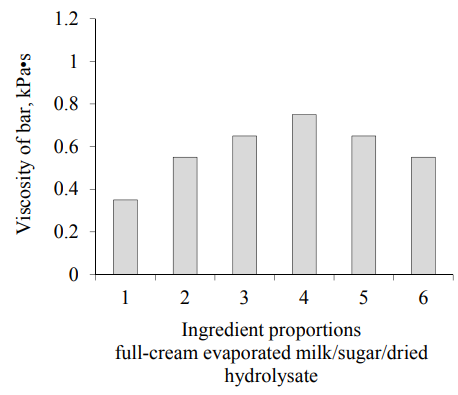
According to the data in Figures 2–9, the bar viscosity depends on temperature; the higher temperature the lower the viscosity value, which corresponds to general theory of viscosity. Also, viscosity characteristics of the bar increase with the increase of full-cream evaporated milk content and the decrease of sugar amount. It should be noted that in samples with increased amount of the dried hydrolysate of packed RBCs viscosity value has increased; in other words, increased quantity of iron in the bar causes increased internal friction of bar layers.
In order to determine strength of the bar mixture, elastic limit for different proportions of full-cream evaporated milk, sugar, and dried hydrolysate was analyzed. The diagram of force distribution over time is shown in Fig. 10.
{img=
The results demonstrate the curve of the dependence of characteristic time of cutting the bar on ingredient proportions to have the minimum value when proportions are 110 : 32 : 3. Also, the time of cutting has minimum value for samples with ingredient proportions 110 : 33 : 2 and 105 : 37 : 3. Consequently, bars with such proportions of components have maximum elastic properties.
Fig. 11 demonstrates changes of elastic-plastic properties of the mixture when changing ingredient proportions.
On the basis of the results in Fig. 11, it can be stated that optimum proportions are 110 : 33 : 2 and 110 : 32 : 3.
Also, dependence of hardness of the mixture on ingredient proportions was studied (Fig. 12).
The mixture with higher sugar content has the greatest hardness. It should be noted that increased quantity of dried hydrolysate reduces the bar hardness.
Changes in density, solids content, and mass fraction of iron in the bar mixture at varying ingredient proportions were also studied. The results are represented in Table 5.
The data in Table 5 show density and solids content to be increased with higher sugar content and lower amount of full-cream evaporated milk. Optimum values of density (1265 ± 30 kg/m3 , 1285 ± 30 kg/m3 ) and solids content (63.0 ± 0.1%, 64.0 ± 0.1%) take place when ingredient proportions are 110 : 33 : 2 and 110 : 32 : 3 where mass fraction of iron in the first and the second samples is 12 ± 0.5 and 17 ± 0.5 respectively.
Thus, from the results of the study of such properties of bar mixture as viscosity, characteristic time of cutting, relative deformation, hardness, density, solids content, and mass fraction of iron, proportions 110 : 33 : 2 and 110 : 32 : 3 (full-cream evaporated milk : sugar : dried hydrolysate) were chosen as optimal.
Formulations of bars are represented in Table 6.
The technological process of the bar consists of several interrelated stages.
(1) Preparation of ingredients. All the ingredients are checked for compliance with the certificate of quality in relation to the presence of extraneous impurities. In case of non-compliance, that ingredient is rejecting.
(2) Syrup making: Sugar and water are heated, fullcream evaporated milk is added and syrup obtained is boiled out until solids content is 85%. (3) The making of bar mixture: Vanillin and ascorbic and citric acids are added into the syrup cooled to 45–65°C then all is thoroughly whipped. The fondant obtained is heated up to 70–75°C with constant stirring, mixed with dried hydrolysate of packed RBCs, and stirred at constant temperature until candy mass is obtained. The candy layer is formed, cooled in a refrigerator to 35–40°C, and then cut to pieces which are subjected to cooling to 20–25°C for 30 minutes.
The next stage included the study of organoleptic and physicochemical, microbiological and toxicological parameters in final bars. Organoleptic and physicochemical properties of the bar are presented in Tables 6 and 7.
Analysis of the results indicate the bar with antianemic agent from farm animal blood, produced by using developed formations, to conform to requirements of GOST 30058-95 in organoleptic (surface, texture, color, consistency, taste, and flavor) and physicochemical (moisture content and mass fraction of ash) characteristics.
Toxic elements content in the bar with anti-anemic properties is shown in Table 8.
According to the data in Table 8, the bar made by using developed formulation complies with requirements of SanPiN 2.3.2.1078-01.
Microbiological parameters of the bar are reflected in Table 9.
The data show that the bar made by using developed formulation conforms to requirements of GOST 30058-95 in microbiological parameters.
Thus, the following conclusions can be made:
(1) The confection, namely, a sherbet-like bar
containing the dried hydrolysate of packed RBCs as an
anti-anemic agent, was developed. The following
ingredients were used: full-cream evaporated milk,
sugar, vanillin, dried hydrolysate of packed RBCs, and
citric and ascorbic acids. Full-cream evaporated milk,
sugar, and vanillin give the product taste
characteristics, while the acids were used to enhance
taste and stimulate iron assimilation by a human body.
(2) Quality characteristics of the dried hydrolysate of
packed RBCs as an anti-anemic agent were studied. The
results obtained show the hydrolysate to be a dehydrate
mixture of amino-peptide complexes with heme iron.
(3) Rheological properties of the sherbet-like bar, such
as viscosity, elastic properties, hardness, and
characteristic time of cutting, were studied. On the
basis of the results obtained, two optimum
formulations of the sherbet-like bar with anti-anemic
agent on farm animal blood were chosen (Table 6).
(4) Organoleptic, physicochemical, microbiological,
and toxicological properties of the sherbet-like bar with
anti-anemic agent were investigated. It is proved that
the bar produced by using the developed formations
conforms to requirements of GOST 30058-95 in
organoleptic, physicochemical, and microbiological
characteristics and SanPiN 2.3.2.1078-01 in
toxicological parameters.
СПИСОК ЛИТЕРАТУРЫ
- Kornillowicz-Kowalska T. and Bohacz J. Biodegradation of keratin waste: Theory and practical aspects. Waste management, 2011, vol. 31, no. 8, pp. 1689-1701. DOI: 10.1016/j.wasman.2011.03.024.
- Cadée J.A., Chang C.Y., Chen C.W., et al. Bovine casein hydrolysate (c12 Peptide) reduces blood pressure in prehypertensive subjects. American Journal of Hypertension, 2007, vol. 20, no. 1, pp. 1-5. DOI: 10.1016/j.amjhyper.2006.06.005.
- Fayvishevskiy М.L. Anti-anemic products based on slaughter animal blood. Meat Industry, 2011, no. 6, pp. 43-45. (In Russian).
- Schmidt R. and Thews G. (eds). Human Physiology. 3rd ed. In 3 vols. Vol. 2. Berlin, Heidelberg: Springer-Verlag, 1989. 827 p. DOI: 10.1007/978-3-642-73831-9. (Russ. ed.: Schmidt R. and Thews G. (eds). Fiziologiya cheloveka. Moscow: Mir Publ., 2005. 314 p.).
- Kim S.B., Ki K.S., Khan M.A., et al. Peptic and tryptic hydrolysis of native and heated whey protein to reduce its antigenicity. Journal of Dairy Science, 2007, vol. 90, no. 9, pp. 4043-4050. DOI: 10.3168/jds.2007-0169.
- Cheison S.C., Wang Z., and Xu S.Y. Preparation of whey protein hydrolysates using a single- and two-stage enzymatic membrane reactor and their immunological and antioxidant properties: characterization by multivariate data analysis. Journal of Agricultural and Food Chemistry, 2007, vol. 55, no. 10, pp. 3896-3904. DOI 10.1021/jf062936i.
- Prosekov A.Yu., Krieger O.V., and Lisitsyn A.B. Characteristics of the molecular weight distribution of the prion protein fractions in blood and milk processing products. Biosciences Biotechnology Research Asia, 2016, vol. 13, no. 1, рр. 85-90. DOI: 10.13005/bbra/2007.
- Izgaryshev A.V., Babich O.O., Karchin K.V., et al. Hydrolysis of the red blood cells of pig and cattle to ensure optimum conditions for the manufacturing of iron-containing products having maximum heme iron. Biology and Medicine, vol. 8, no. 6, article number 330. DOI: 10.4172/0974-8369.1000330.
- Izgaryshev А.V. New techniques of anti-anemic products from slaughter animal blood. Storage and processing of farm products, 2010, no. 2, pp. 50-52. (In Russian).


